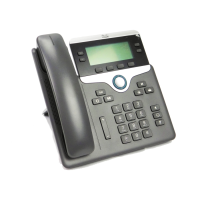authenticator at the LAN switch. The pass-through mechanism ensures that the IP phone does not act as the
LAN switch to authenticate a data endpoint before accessing the network.
Cisco IP Phones also provide a proxy EAPOL Logoff mechanism. In the event that the locally attached PC
disconnects from the IP phone, the LAN switch does not see the physical link fail, because the link between
the LAN switch and the IP phone is maintained. To avoid compromising network integrity, the IP phone sends
an EAPOL-Logoff message to the switch on behalf of the downstream PC, which triggers the LAN switch to
clear the authentication entry for the downstream PC.
Support for 802.1X authentication requires several components:
•
Cisco IP Phone: The phone initiates the request to access the network. Cisco IP Phones contain an 802.1X
supplicant. This supplicant allows network administrators to control the connectivity of IP phones to
the LAN switch ports. The current release of the phone 802.1X supplicant uses the EAP-FAST and
EAP-TLS options for network authentication.
•
Cisco Catalyst Switch (or other third-party switch): The switch must support 802.1X, so it can act as
the authenticator and pass the messages between the phone and the authentication server. After the
exchange completes, the switch grants or denies the phone access to the network.
You must perform the following actions to configure 802.1X.
•
Configure the other components before you enable 802.1X Authentication on the phone.
•
Configure PC Port: The 802.1X standard does not consider VLANs and thus recommends that only a
single device should be authenticated to a specific switch port. However, some switches (including Cisco
Catalyst switches) support multidomain authentication. The switch configuration determines whether
you can connect a PC to the PC port of the phone.
◦
Enabled: If you are using a switch that supports multidomain authentication, you can enable the
PC port and connect a PC to it. In this case, Cisco IP Phones support proxy EAPOL-Logoff to
monitor the authentication exchanges between the switch and the attached PC. For more information
about IEEE 802.1X support on the Cisco Catalyst switches, see the Cisco Catalyst switch
configuration guides at:
http://www.cisco.com/en/US/products/hw/switches/ps708/tsd_products_support_series_home.html
◦
Disabled: If the switch does not support multiple 802.1X-compliant devices on the same port, you
should disable the PC Port when 802.1X authentication is enabled. If you do not disable this port
and subsequently attempt to attach a PC to it, the switch denies network access to both the phone
and the PC.
•
Configure Voice VLAN: Because the 802.1X standard does not account for VLANs, you should configure
this setting based on the switch support.
◦
Enabled: If you are using a switch that supports multidomain authentication, you can continue to
use the voice VLAN.
◦
Disabled: If the switch does not support multidomain authentication, disable the Voice VLAN and
consider assigning the port to the native VLAN.
Related Topics
Cisco Unified Communications Manager Documentation, on page xiii
Cisco IP Phone 7800 Series Administration Guide for Cisco Unified Communications Manager
104
Supported Security Features

